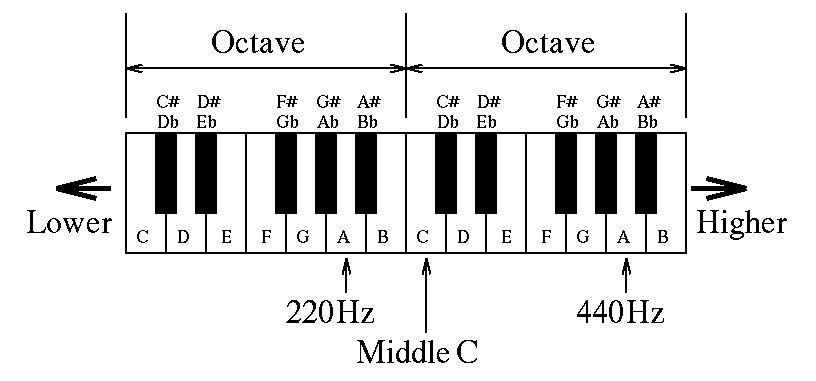In this day and age, music can be digitalized; even the instruments producing music have digital siblings. Original acoustic pianos are now joined with digital pianos, keyboards, and synthesizers. Music is a form of expression that requires no knowledge of a language to understand, just an ear to listen and a heart to feel. Technological advances have changed its systems and thus impact the "language."
Aural Tuning Uses Physics, Electronic Tuning Uses Numbers
There are two types of tuning methods: aural tuning and electronic tuning. Aural tuning, also called traditional tuning, relates to the ear or sense of hearing. The piano is usually tuned to A 440, meaning the musical note A above "Middle C" is at a frequency of 440 Hertz. The tuner tunes the middle string of the note and then tunes the other two string so that they are all in unison. One octave is then tuned to 12 Tone Equal Temperament, where the interval between keys adjacent to each other are equal (counting the black keys).
Next, the tuner checks the tuning of common intervals and then uses that octave to tune the rest of the piano listening for "beats."As the diagram on the left portrays, when two slightly different frequencies are played together, they result in bumps, referred to as "beats." The lack of beats indicates the notes are in tune.
Have you ever heard a "whomp, whomp" sound? Those are beats created by two slightly different pitches.
Below is a guitar demonstrating this phenomena. See if you can hear those beats!
The first audio played two strings that were in tune while the second audio played two strings slightly out of tune. Were you able to tell the difference?
On the other hand, electronic tuning uses what are called "visual tuning devices." The devices will tell the tuner if that note is at the correct frequency and the string will be tightened or loosened accordingly. This process can be done much more quickly compared to aural tuning and can be executed in a noisy room with the aid of headphones. The device can also record tuning which can then be brought out when re-tuning that same piano. To a piano technician, utilizing an electronic device shortens the learning process and is easier to get to a certain level quickly. Aural tuning takes years and years of practice to do good tuning.
Tuning Method Results Vary Oh So Slightly
Ming Li is the chief piano technician at the University of Maryland and has been with the school for 22 years, with a certificate to prove it! Li has been in the business for more than 30 years and started in China with his interest for piano technology. Li believes tuning is like a musical art and enjoys listening to the tones. He personally prefers aural tuning; "each piano is different." Li says that most people cannot tell the hear a difference between the tuning methods. People who call and ask about tuning either have a good ear for it, or trust traditional tuning.
Chia-Hsuan Lee received her master's degree in piano performance from the University of Maryland and has been teaching piano for more than 20 years. Lee is most intrigued by the sound quality of a piano. Although she regards electronic tuning as efficient, "a real piano tuner needs to really listen to get the good sound quality."
Piano strings are also impacted by something called inharmonicity. Strings of higher notes have immense tension and strings of lower notes are stiff due to its thickness. Therefore, higher notes need to be tuned higher in frequency than in theory to sound in tune. Lower notes need to be tuned to a lower frequency than in theory. Although an electric tuner can distinguish between close frequencies, Li demonstrates what small differences that he believes only the ear can hear:
Li describes the sound of an electronically tuned piano as sounding too square and boring. Sometimes "too perfect" is not good, just like in visual art. Though, Li says he may consider using an electronic device in the future when his hearing is not as good to lengthen his career.
The Structure of the Piano Changes Materials and Then Goes Digital
The body of the piano is traditionally made of wood. Today, many piano part materials are replaced by composite wood or plastic, which are much cheaper compared to solid wood. Although, at first, those materials were not successful, but with time the quality has improved. Li foresees that in the future, most piano manufactures will use composite materials. He also proudly shares that Steinway pianos do not use plastic parts and each are 90% handmade. (Li went to Steinway for complete training.)
Technology has also allowed the entire piano to go digital. Digital pianos are equipped with computer chips that reproduce sounds of the piano. Good quality digital pianos have keys that are weight sensitive. Lee believes digital pianos will not be able to replicate a real piano because its sound "has no life."
Jane Shih is a engineer by trade but has a love for music that has followed her throughout the years. She has been involved with music since she started playing the piano at the age of five and a half years old. Shih describes what she sees as the difference between a digital piano and an acoustic piano:
Although Shih loves working with an acoustic piano, she does not completely disapprove of the digital piano. She also enjoys playing with the functions on a synthesizer and with different "voices and layers" a single piano cannot do.
Although there are still gaps between how close technology can recreate a piano and its sound and distinguish subtle tones, only time will tell if it one day can express like a real piano.With all this talk of music, please enjoy a small clip from Shih:


.JPG)

No comments:
Post a Comment